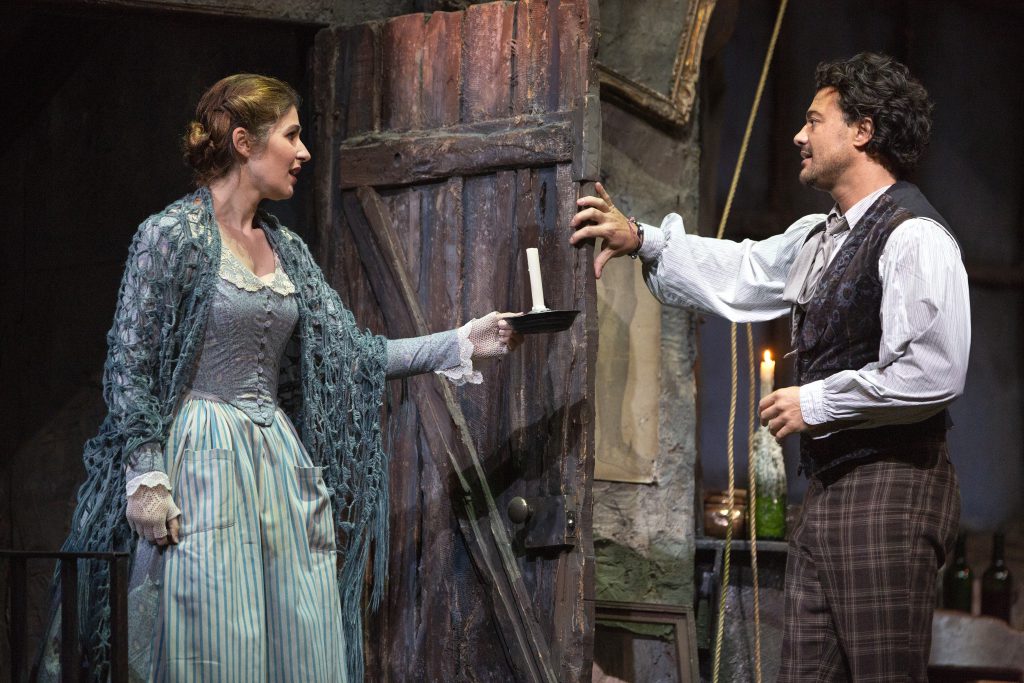Nicole Car brings intimate artistry to Met’s “Boheme” in company debut

Nicole Car and Vittorio Grigolo star in Puccini’s “La Boheme” at the Metropolitan Opera. Photo: Marty Sohl
Franco Zeffirelli’s Metropolitan Opera production of La Bohème is within sight of its 40th birthday. The staging’s age and constancy, along with the realism of time and place that Zeffirelli values, give it a strange timelessness—as each second moves us into the future, the Met’s La Bohème remains eternal.
That doesn’t mean, of course, that the performances stay eternally fresh from night to night; success or failure depends entirely on the singing and the music making. Yet the Met’s revival, which opened Tuesday night, succeeds on both those counts.
What makes this season’s Bohème notable is that it features the Met debuts of soprano Nicole Car as the consumptive Mimi, baritone Etienne Dupuis (Car’s husband), as the painter Marcello, and conductor James Gaffigan. Interest was highest in Car, a rising star who has already sung the role at other houses, including Covent Garden and the Paris Opera.
Her performance was impressive, even though she never seemed completely right for the special demands the Metropolitan Opera House places on vocal artists. Her singing and vocal characterization were deeply artistic, full of feeling while always unadorned, never showy or indulgent. Puccini’s characters are never fully realized in the manner of Verdi or Mozart; his music often dominates key dramatic moments, where the singing is a part but not the leading feature.
In contrast to what is typically heard in this opera, Car was understated, her phrases simply going from start to finish with great beauty and elegance. One’s attention was drawn directly to the character, what she was thinking and feeling. This was especially striking throughout the Act III scenes with her beloved, the painter Rodolfo (tenor Vittorio Grigolo) and Marcello. Her legato lines in “Dunque è prioprio finita!” were exceptionally musical.
Mimi and Rodolfo’s duets are the musical high points of the opera. Yet against Grigolo’s astonishing ability to project through the entire orchestra and into the house, Car’s relatively quiet singing was often buried. Her voice was overwhelmed by Grigolo, especially in Act I. Car’s “Mi chiamano Mimi” was so real that it made the rest of the performance work, but the imbalance of passion in “O soave fanciulla” was ungainly.
Grigolo is arguably the finest contemporary Rodolfo, and possessed all of the poet’s youthful, romantic fervor, with a tenor that has warmth and a kind of naïve sincerity. His “Che gelida manina” was luscious.
The quartet of men was rounded out by baritone Davide Luciano as the composer Schaunard and bass Matthew Rose as Colline, a philosopher. Their camaraderie, though never rising to the level of broad comedy, was good natured; all the cast’s singing was not only fine but had a lithe interplay that keep the music moving.
Marcello is the most important secondary role and, as with Grigolo, his vocal dialogue with Mimi in Act III was dramatic and involving, a complex conflict. One was tempted to speculate that the offstage relationship between Car and Dupuis was responsible for the superb balance and mix between her soprano and his equally gentle, smooth baritone.
The opera’s humor came through via soprano Angel Blue’s Musetta, with a little help from the outrageously vivid red velvet gown she wears at Café Momus in Act II. The vitality of her “Quando m’en vo’” dominated that scene, and the interior life of the character came through in her intense anger and sorrow at Mimi’s death.
Gaffigan has shown a precise and active (though not fussy) technique in his appearances with the New York Philharmonic, qualities that he brought to the pit at the Met. The pace and flow of the music through the first two acts were ideal enough that one never noticed the orchestra as something separate from the singing and staging. Act III, which is the finest in the opera, was exceptionally well done, a series of gorgeous colors and captivating swells and declines in dynamics. The tempos were measured in the best sense, marking the drama and moving it on with purpose to the next event.
Unfortunately, the pace flagged in the final act. The colors were still there and the accompaniments for the singers just as careful as previously, but the dramatic momentum just stopped. If this was an interpretive decision to create a sense of meditative stillness around Mimi’s last moments and the last expressions of love between her and Rodolfo, it didn’t work. Rather, a sense of enervation crept in. “Sono andati?” didn’t have the depth of feeling to break the heart. Nor was there sufficient contrast between the Bohemians’ initial playing and the penultimate moment of silence to bring out the tragedy in Mimi’s death—not only did her companions not notice as they fussed around the garret, neither did the audience.
La Bohème continues through December 13. Ailyn Pérez sings Mimi, Michael Fabiano sings Rodolfo, and Lucas Meachem sings Marcello beginning November 29. metopera.org; 212-362-2000